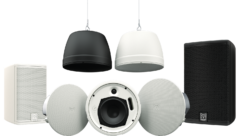Consumer Influence In Pro AV
The influx of consumer gear into professional systems is a quantum leap backward for audio and video.
Pat Brown
I RECENTLY READ an article that suggested the consumer marketplace is driving the professional audio industry. It stated that if you want to keep a finger on the pulse of the up-and-coming, you should attend CEDIA rather than NSCA or InfoComm. There’s certainly some truth to this, but it’s important to look at both sides of the issue.
It’s true that many of the new gizmos are introduced at CEDIA. It’s also true that corporate customers may request these for their boardroom or other commercial systems. But, there are some very good reasons why consumer gear may not be appropriate for the professional marketplace. The main one is obvious — consumer gear isn’t professional! These are separate equipment categories that have significant differences. The blurring of the line between them isn’t a good trend and shouldn’t be encouraged.
Before you get defensive, let me clarify that I’m not saying consumer gear is low quality. To the contrary, due to the size of the market, a lot of big bucks get thrown at consumer product design. But there are significant differences between products and practices designed for use in the home and those that are appropriate for professional systems.
Analog I/O topology
Inputs and outputs on consumer gear use an unbalanced electrical interface. In an unbalanced audio interface, the signal originates at a “single-ended,” low impedance output that drives a single-ended, high impedance input. The output voltage is typically developed between a “hot” terminal and the audio ground. The input port is configured the same way. Cable topology is usually a coaxial single conductor and shield, with the shield connected between the audio grounds of the products. This interface topology was first used in some of the earliest radio receivers to pass the signal between stages within the product. It was never intended to be an “outside of the box” method for signal distribution, although this fact didn’t keep it from getting used for just that. The main drawback to the unbalanced interface is that it doesn’t have noise immunity. Professional products use balanced I/O — a necessity for reducing hum and buzz susceptibility for the long cables typical in commercial systems.
Signal levels
Consumer gear has a typical average operating voltage of about 1/3 volt. Expressed as a level referenced to 1 V, this is -10 dBV. An additional 14 dB to 16 dB is usually provided for signal peaks. Professional audio gear has a typical average operating voltage of about 1.23 V. Expressed as a level referenced to 1 V, this is 2.2 dBV. I’ve referenced both levels to 1 V (0 dBV) to make it easy to see the 12.2 dB level difference between the signals. Professional levels are higher because the signals typically must drive longer cables in noisier environments (electromagnetically speaking). Consumer gear can get into big trouble in these applications. Every widget that you add to compensate for this level disparity adds variables to the performance of the system.
Digital I/0
TOSLINK and SPDIF digital I/O overcome many of the shortcomings of analog unbalanced I/O, at least for the audio side of things. But most professional mixers don’t support these, so converter boxes are needed. These boxes add variables to the signal chain. Digital links also introduce AD and DA converters, which add latency (delay) that can cause synchronization problems with other gear. There can also be signal degradation due to poor gain structure. I recently encountered a fiber converter box that clipped at one volt input! It had to be driven through a pad, which adds another variable to the signal chain. Digital can be good, but there are different standards for digital I/O for the consumer and pro markets. As with analog I/O, professional digital I/O is much more robust.
Bandwidth
Consumer gear is often designed to have impressive “DC to daylight” bandwidth specifications. This tends to win over people who are doing comparison shopping. In the pro audio world, we gladly give up bandwidth to achieve stability. It’s simply unacceptable for the bandwidth of a product to exceed 100 kHz, and in most cases, it’s less. This is because we don’t want radio frequency signals to be amplified and sent to loudspeakers. Plus, the trend toward Class D amplification means that there’s more RF energy present that must be rejected. There’s a price to be paid for being small and light.
Grounding
Some professional audio manufacturers have attempted to accommodate consumer gear by providing unbalanced, consumer-level inputs on their products. They don’t do this because it’s a good idea, but because there’s pressure in the marketplace caused by end-users embracing mass-marketed, cheap program sources. While an “iPod Pro” with professional I/O would be a useful item, it would likely fail in the marketplace because it would cost two to three times more than the consumer version. The ongoing “quest for cheap” will likely always plague the professional audio industry.
The consumer market is indeed influencing the professional marketplace, but this influence is mostly negative. We’ve got the cart leading the horse and the tail wagging the dog. The field of mediocre, over-marketed AV products is growing like wildfire, driven by sales forces that are yielding to the whims of the consumer. Most of the new audio gear in the consumer market is disposable. It can’t be fixed if it breaks. The same design and manufacturing practices that produce this stuff are finding their way into the pro audio world. Manufacturers are pressured to build a cheaper mouse trap to compete with “consumer gear in disguise” products that bleed over from the consumer market. A full-page color ad filled with lots of adjectives, color photos, and claims that can’t be proven or disproved will produce more sales than a product that’s designed to be serviced and is supported by an honest spec sheet that yields the necessary information to properly implement it.
There’s a place for consumer gear and a place for professional gear. This distinction has evolved for some very good reasons. The consumer marketplace is largely driven by one concept: cheap prices. This is evident in the product designs as well as the way that they’re marketed to consumers. To illustrate my point, I challenge you to go out and purchase a high-quality portable CD player. There aren’t any. Instead there are rows of blister-packed junk designed to play music that was processed to play loud rather than with high fidelity.
Professional audio should represent higher quality, greater stability, and the robustness necessary to reliably function in hostile environments. Professional gear costs more than consumer gear, and it should. Audio system designers and sales forces must understand the differences between these products, and market them accordingly. From an engineering perspective, it makes much more sense to modify professional gear for the consumer market than to modify consumer gear for the professional market. But because the latter is likely to continue as the norm, audio practitioners must understand the fundamental differences between consumer and pro products, and insist on professional products for critical applications. Once the line from consumer to commercial is crossed, all applications become critical.
Pat Brown is president of Synergetic Audio Concepts (Syn-Aud-Con) Inc. and Electro-Acoustic Testing Company (ETC) Inc. Syn-Aud-Con conducts training seminars in audio and acoustics worldwide for those who operate, install, and design sound reinforcement systems. ETC Inc. performs precision loudspeaker testing for the audio industry. He can be reached at [email protected].










